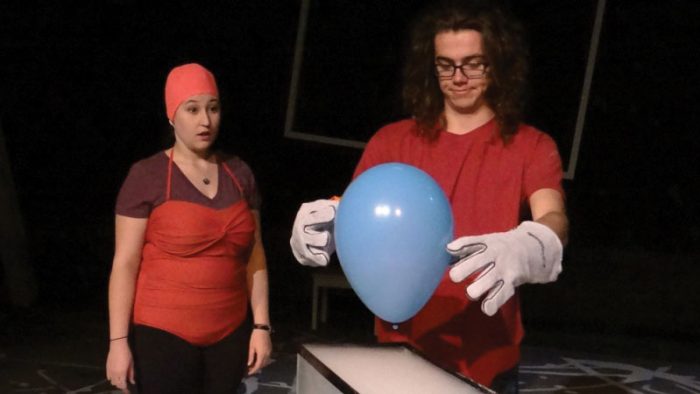 Humanities
Humanities
It’s a Wonder-ful World

Dylan Carlini studies the Earth, from the surface to the deep interior. This calls on his command not just of his major—earth sciences—but also biology, chemistry, mathematics and physics.
But last year, Carlini’s passion for geology led him to a new field altogether: theater arts.
Week after week, Carlini and other students in the sciences met with John Schmor, head of the theater department. Together, they dreamed up a dramatic way to teach science—by putting it on stage.
The resulting play, “Wonder If Wonder Why”—performed on campus last spring and then for schools along the Oregon coast—brought together students and faculty from theater arts, history, English and the sciences in dramatizing such heady topics as sublimation, density, wavelengths and the speed of light.
Carlini served as the production’s resident geologist, signing off on the accuracy of concepts drawn from his area of study.
“Every day we had theater class, I would come straight from a geology class,” Carlini said. “So my ‘science mind’ was already running.”
The idea for the play came to Schmor after he read about a growing antipathy in the US toward studying science.
He found a willing collaborator in physics instructor Stanley Micklavzina, who is known for his creative approach to science education. He has demonstrated the concept of light refraction, for example, by dimming the lights in a lecture hall, cranking up a fog machine and performing a laser light show to songs by Pink Floyd.
The cast and crew framed the play around a paradoxical question: Why are so many people afraid of scientific thinking at the same time that we depend every day on its constant advances?
A script rich in physics and biology was written from interviews that the cast conducted with science faculty.
In one scene, the theater was darkened to simulate the ocean, then lit up with glowing sea creatures. In another, actors portrayed French physicists Hippolyte Fizeau and Léon Foucault, dashing across the stage in a race to discover the speed of light as a narrator put their ideas into perspective for the audience.
“How fast is 299,792 kilometers a second?” she asked. “If you were going that fast, you could circumnavigate the earth seven and a half times—in a second.”
Props included Slinky toys used to demonstrate wavelengths and inflated balloons that served in demonstrating the density of carbon dioxide.
After a two-week run on campus in the spring, Schmor and the cast took the show on the road in the fall, bringing the wonders of science to elementary and middle schools in small coastal Oregon towns from Newport to Brookings.
“The students would spend the whole show laughing, oohing and ahhing, and staring wide-eyed during scenes,” said performer Ellie Jones, a marine biology major. “It was an audience of people who wondered.”
Schmor called the tour one of the most important of his teaching career.
“To be giving theater to children who have never seen theater before, or to awaken wonder about science for those who think it’s just about facts and figures?” he said. “It was golden.”
—Emily Halnon
Photo caption: Props included Slinky toys used to demonstrate wavelengths and inflated balloons that illustrated the density of carbon dioxide.
Photo credit: Ariel Ogden, Theatre Arts


 Twitter
Twitter Facebook
Facebook Forward
Forward